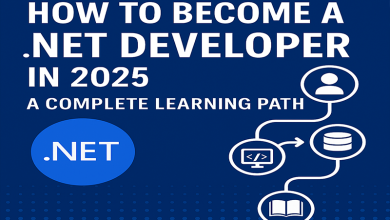How to Become a Professional React Developer in 2025

React.js has revolutionized modern front-end development. With its component-based architecture, strong community, and high demand in the job market, React has become a must-learn technology for every aspiring front-end developer. Whether you’re a student, self-taught developer, or switching careers, this complete guide will help you learn React and become a professional React developer in 2025.
1. Start with Core Web Development Skills
Before learning React, build a solid foundation in:
- HTML5: Semantic tags, forms, inputs, basic SEO structure
- CSS3: Flexbox, Grid, animations, responsive design
- JavaScript (ES6+): Arrow functions, promises, async/await, modules, destructuring, array methods like
map,filter, andreduce
These skills are essential since React is built on top of JavaScript, and you’ll be writing JSX which blends HTML and JS syntax.
2. Learn the Fundamentals of React
Start with the basics by exploring:
- JSX Syntax (React’s HTML-like syntax inside JS)
- Components (Functional & Class-based)
- Props & State (how data flows in React)
- Event Handling (onClick, onChange, etc.)
- Conditional Rendering (if, ternary, &&)
- Lists & Keys (
.map()to render dynamic content)
Build simple components like buttons, forms, or counters to apply what you learn.
3. Master React Hooks
Hooks allow you to manage state and lifecycle inside functional components without using classes. Learn:
useState()for local component stateuseEffect()for side effects (like fetching data)useRef(),useContext()useReducer()for more complex state logic- Custom Hooks (to reuse logic between components)
Hooks are essential for writing clean, modern React code.
4. Learn Routing with React Router
Most real-world apps have multiple pages. Use React Router DOM to:
- Create dynamic routes (
/users/:id) - Navigate between pages
- Use
useNavigate()for programmatic routing - Build protected routes for auth-based systems
5. Understand State Management
As your app grows, managing state becomes challenging. Learn:
- Context API for light global state
- Redux Toolkit for large-scale applications
- Understand actions, reducers, dispatch, and middleware
- Explore alternatives like Zustand or Recoil
6. Connect to APIs
Most apps need to fetch data. Learn:
- How to use
fetch()oraxios - Handle loading and error states
- Use tools like React Query or SWR for advanced data fetching and caching
7. Work with Forms and Validation
Forms are everywhere. Learn:
- Controlled vs uncontrolled components
- Use
useState()or form libraries like Formik - Validate inputs using Yup or custom validation
- Build login, registration, contact forms, etc.
8. Learn TypeScript with React
TypeScript is highly recommended in modern React development:
- Type your props and components
- Use interfaces and generics
- Improve error detection and code clarity
- Most jobs now require TypeScript knowledge
9. Optimize Performance
Professional React developers care about performance. Learn:
- Lazy loading with
React.lazy()andSuspense - Memoization with
React.memo,useMemo,useCallback - Avoid unnecessary re-renders
- Analyze performance using React DevTools
10. Build Real Projects and a Portfolio
Apply everything you learned by building:
- An e-commerce store
- A personal blog
- A dashboard with charts
- A movie search app using APIs
- A portfolio website with live demos
Deploy your projects using Vercel, Netlify, or Firebase, and showcase them on GitHub and LinkedIn.
Final Tips
Becoming a professional React developer takes time and consistent practice. Join the React community, follow blogs, contribute to open-source, and keep improving. If you follow this roadmap step-by-step and apply your skills in real projects, you’ll be job-ready and confident with React in no time.
SEO Keywords: react developer roadmap, how to become a react developer, learn react, react js learning path, react developer skills, front-end developer

